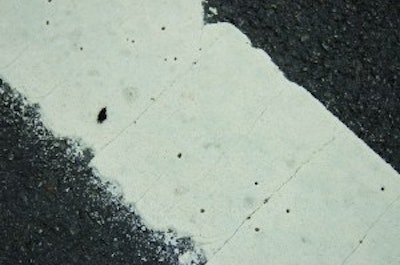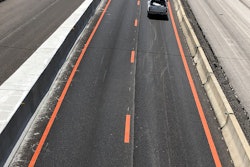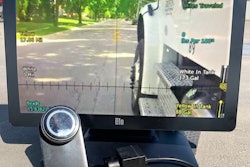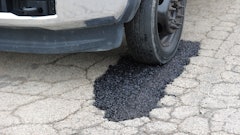
In a proper thermoplastic application, the line is straight with a sharp edge and correct color, thickness, bonding and retroreflectivity. But thermoplastic pavement markings don't always go down smoothly. Here are some possible problems or defects that can occur during thermoplastic application.
No Adhesion. Lack of bonding between the thermoplastic material and the pavement surface is a major issue. When there is a lack of adhesion a bulge often forms at the beginning of the line. Adhesion problems can occur if the material temperature is too low, application was done at too fast a speed, or the pavement surface is too dirty or too cold.
Roughened, Pitted Lines. Foreign objects in the thermoplastic application line or caught in the die can cause rough, pitted lines. Overheating thermoplastic material can also be a culprit. Overheating forms a crust in the thermoplastic material.
Gas Bubbles. If gas bubbles appear in the thermoplastic marking it is probably due to moisture or a solvent trapped in or under the thermoplastic line or the material was overheated.
Crumbly Edges/Line Gaps. Crumbling or gaps can occur when the material is too cold, the application speed is too fast, or the material is applied too thin.
Crumbly Edges/Rough Line Surface. Temperature and moisture are the two main factors that can create a rough, crumbling line. Overheated or too cool material can create this result. Moisture in the pavement is also a possibility.
Swollen Line. A swollen line is one with a skewed and rounded line at the start of the marking. This happens when the thermoplastic material is too hot.
Shadows. Shadows on the sides of a thermoplastic marking are a result of a heavily undulated road surface or the equipment's die not riding evenly on the substrate.
Wavy Lines. Strong road surface camber, poor driver/operator direction, and strong road surface undulations all cause wavy lines during thermoplastic application.
Cracks. Cracks in applied thermoplastic lines can occur immediately after application or in the future. This can happen if the pavement surface is cracked. However, these types of cracks will not affect the thermoplastic's durability. Other causes of cracks include material applied too thin or too cold or temperature stress from overheating.
Jagged Line Endings. If the ends of the thermoplastic marking are jagged or there are drops within gaps it is mostly likely an issue with the die. This can happen if a die is not closing properly or if foreign objects are caught in the die.
Excessive Overspray. When spraying thermoplastic material a light dusting of overspray is normal. However, if the overspray is excessive it is likely due to too much atomizing pressure in the spray gun or air leaking through and being blown back into the spray line.
Hesitation at the Start. If the line shows sings of a hesitant start check the spray line to make sure it is clear of moisture and air. Another cause could be material that is either too hot or too cold.
Lumps. If the thermoplastic material is spraying down in lumps the material is too cold and needs to be heated to the proper temperature.
Information provided by Pervo Paint Co. and Ennis Traffic Safety Solutions.



















